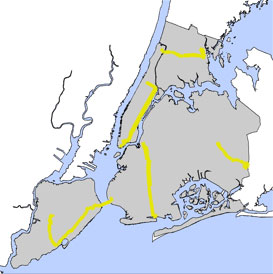Stimulus Package on Track to Perpetuate Transpo Status Quo
 Will stimulus cash help implement New York’s five BRT pilot routes? Image: Gotham Gazette.
Will stimulus cash help implement New York’s five BRT pilot routes? Image: Gotham Gazette.A front page story in yesterday’s Washington Post has the most thorough analysis to date of how infrastructure spending may be divvied up in an Obama stimulus package. Nothing is set in stone, but the dividing lines are increasingly clear: States and their DOTs are emphasizing road projects, while cities are looking for ways to reduce congestion. The emphasis on getting shovels in the ground quickly will also skew spending, says Minneapolis Mayor R.T. Rybak:
"The quickest things we can do may not be the ones that have the most
significant long-term impact on the green economy," he said. "Unless we
push a transit investment, this will end up being a stimulus package
that rebalances our transportation strategy toward roads and away from
[what] we need to get off our addiction to oil."Mayors say there would be a better chance for a long-term impact if
the money were focused on metropolitan areas where investments could
make the most difference in reducing congestion and lessening
dependence on cars. They doubt that will happen if infrastructure
funding goes directly to state capitals.As it stands, Congress, wanting to keep things simple, plans to
disburse the money under existing formulas — funding for roads and
bridges will go to state governments, while money for public transit
will go to the local agencies that receive transit funding.
Yes, there will be another window of opportunity to overhaul the existing formula and other bad habits with next year’s big transportation bill. For now, however, the lack of vision is startling. As Smart Growth America’s David Goldberg says in the Post, "It doesn’t have the power to stir men’s souls." Some signal that the nation is moving in a new direction is in order.
Even in New York, a land of mega-projects where the regional transit agency has immense needs, the MTA is asking for nothing more ambitious than station rehabs and accelerated track replacement.
So what would a visionary infrastructure stimulus for New York look like? How about physically separated, radial BRT lines connecting the outer boroughs to Manhattan (or at least implementing the BRT pilot plan that’s been public for more than two years). Or an accelerated and expanded build-out of the protected bike path network. If there was ever a time to think big, now is the moment.





